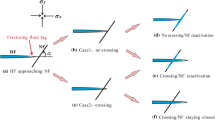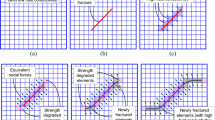Abstract
We present an extended finite element framework to numerically study competing hydraulic fracture propagation. The framework is capable of modeling fully coupled hydraulic fracturing processes including fracture propagation, elastoplastic bulk deformation and fluid flow inside both fractures and the wellbore. In particular, the framework incorporates the classical orifice equation to capture fluid pressure loss across perforation clusters linking the wellbore with fractures. Dynamic fluid partitioning among fractures during propagation is solved together with other coupled factors, such as wellbore pressure loss (\(\Delta p_w\)), perforation pressure loss (\(\Delta p\)), interaction stress (\(\sigma _\mathrm{int}\)) and fracture propagation. By numerical examples, we study the effects of perforation pressure loss and wellbore pressure loss on competing fracture propagation under plane-strain conditions. Two dimensionless parameters \(\Gamma = \sigma _\mathrm{int}/\Delta p\) and \(\Lambda = \Delta p_w/\Delta p\) are used to describe the transition from uniform fracture propagation to preferential fracture propagation. The numerical examples demonstrate the dimensionless parameter \(\Gamma \) also works in the elastoplastic media.




















Similar content being viewed by others
References
Abbas S, Gordeliy E, Peirce A (2016) Modeling multiple curved fractures connected through a wellbore using a fluid-coupled XFEM algorithm. In: 50th US rock mechanics/geomechanics symposium held in Houston, ARMA16-32, 26–29 June 2016, 9 pp
Adachi J, Siebrits E, Peirce A, Desroches J (2007) Computer simulation of hydraulic fractures. Int J Rock Mech Mining Sci 44:739–757
Bao J, Liu H, Zhang G, Jin J, Cheng W, Liu J (2017) Fracture propagation laws in staged hydraulic fracturing and their effects on fracture conductivities. Pet Explor Dev 44(2):281–288
Barenblatt GI (1962) The mathematical theory of equilibrium cracks in brittle fracture. Adv Appl Mech 7:55–129
Belytschko T, Mos N, Usui S, Parimi C (2001) Arbitrary discontinuities in finite elements. Int J Numer Meth Eng 50:993–1013
Bunger AP, Jeffrey RG, Zhang X (2013) Constraints on simultaneous growth of hydraulic fractures from multiple perforation clusters in horizontal wells. SPE Hydraulic Fracturing Technology Conference, The Woodlands. SPE 163860
Bunger AP, Peirce AP (2014) Numerical simulation of simultaneous growth of multiple interacting hydraulic fractures from horizontal wells. Shale Energy Engineering, pp 201–210 (Shale energy engineering conference 2014, Pittsburgh, Pennsylvania, United States, July 21–23, 2014)
Chang X, Shi X, Cheng Y, Han X (2015) The fully coupled fluid flow and geo-mechanics model for simulating simultaneous multiple hydraulic fractures propagation in horizontal wells. In: The 49th US rock mechanics/geomechanics symposium, San Francisco (ARMA 15-607)
Coon ET, Shaw BE, Spiegelman M (2011) A Nitsche-extended finite element method for earthquake rupture on complex fault systems. Comput Methods Appl Mech Eng 200:2859–2870
Crump JB, Conway M (1988) Effects of perforation-entry friction on bottom hole treating analysis. J Petrol Technol 40(8):1041–1049
Detournay E (2016) Mechanics of hydraulic fractures. Annu Rev Fluid Mech 48:311–339
Dolbow J, Moës N, Belytschko T (2001) An extended finite element method for modeling crack growth with frictional contact. Comput Methods Appl Mech Eng 190:6825–6846
Duarte CAM, Oden JT (1996) An HP adaptive method using clouds. Comput Methods Appl Mech Eng 139:237–262
Dugdale DS (1960) Yielding of steel sheets containing slits. J Mech Phys Solids 8:100–104
El-Rabaa AM, Shah SN, Lord DL (1997) New perforation pressure loss correlations for limited entry fracturing treatments. SPE 38373, SPE Rocky Mountain Regional Meeting, Casper, Wyoming
Fries TP, Belytschko T (2010) The extended/generalized finite element method: an overview of the method and its applications. Int J Numer Meth Eng 84:253–304
Garagash DI (2006) Propagation of a plane-strain hydraulic fracture with a fluid lag: early-time solution. Int J Solids Struct 43:5811–5835
Garagash DI (2006) Plane-strain propagation of a fluid-driven fracture during injection and shut-in: asymptotics of large toughness. Eng Fract Mech 73(4):456–481
Garagash DI, Detournay E (2005) Plane-strain propagation of a fluid-driven fracture: small toughness solution. ASME J Appl Mech 72:916–928
Gordeliy E, Detournay E (2011) A fixed grid algorithm for simulating the propagation of a shallow hydraulic fracture with a fluid lag. Int J Numer Anal Meth Geomech 35:602–629
Gordeliy E, Peirce A (2013) Coupling schemes for modeling hydraulic fracture propagation using the XFEM. Comput Methods Appl Mech Eng 253:305–322
Gupta P, Duarte CA (2014) Simulation of non-planar three-dimensional hydraulic fracture propagation. Int J Numer Anal Meth Geomech 38:1397–1430
Gupta P, Duarte CA (2016) Coupled formulation and algorithms for the simulation of non-planar three-dimensional hydraulic fractures using the generalized finite element method. Int J Numer Anal Meth Geomech 40:1402–1437
Gupta P, Duarte CA, Dhankhar A (2017) Accuracy and robustness of SIF extraction methods for the generalized/extended finite element method. Eng Fract Mech 179:120–153
Haghighat E, Pietruszczak S (2015) On modeling of discrete propagation of localized damage in cohesive-frictional materials. Int J Numer Anal Meth Geomech 39:1774–1790
Hillerborg A, Modeer M, Petersson PE (1976) Analysis of crack formation and crack growth in concrete by means of fracture mechanics and finite elements. Cem Concr Res 6:773–781
Hunsweck MJ, Shen Y, Lew AJ (2013) A finite element approach to the simulation of hydraulic fractures with lag. Int J Numer Anal Meth Geomech 37:993–1015
Kumar D, Ghassemi A (2016) A three-dimensional analysis of simultaneous and sequential fracturing of horizontal wells. J Petrol Sci Eng 146:1006–1025
Lecampion B (2009) An extended finite element method for hydraulic fracture problems. Commun Numer Methods Eng 25:121–133
Lecampion B, Desroches J (2015) Simultaneous initiation and growth of multiple radial hydraulic fractures from a horizontal wellbore. J Mech Phys Solids 82:235–258
Liu F, Borja RI (2008) A contact algorithm for frictional crack propagation with the extended finite element method. Int J Numer Meth Eng 76:1489–1512
Liu F, Borja RI (2009) An extended finite element framework for slow-rate frictional faulting with bulk plasticity and variable friction. Int J Numer Anal Meth Geomech 33:1535–1560
Liu F, Borja RI (2010) Finite deformation formulation for embedded frictional crack with the extended finite element method. Int J Numer Meth Eng 82:773–804
Liu F, Borja RI (2010) Stabilized low-order finite elements for frictional contact with the extended finite element method. Comput Methods Appl Mech Eng 199:2456–2471
Liu F, Borja RI (2013) Extended finite element framework for fault rupture dynamics including bulk plasticity. Int J Numer Anal Meth Geomech 37:3087–3111
Liu F, Gordon PA, Meier HA, Valiveti DM (2017) A stabilized extended finite element framework for hydraulic fracturing simulations. Int J Numer Anal Meth Geomech 41(5):654–681
Liu F, Valiveti DM, Gordon PA (2015) Modeling fluid-driven fractures using the generalized finite element method. In: The 49th U.S. symposium on rock mechanics/geomechanics symposium at San Francisco 2015; ARMA-2015-120, 9 pp
Miller CK, Waters GA, Rylander EI (2011) Evaluation of production log data from horizontal wells drilled in organic shales. SPE-144326-MS, North American unconventional gas conference and exhibition, 14–16 June, 2011, The Woodlands, 23 pp
Mohammadnejad T, Andrade JE (2016) Numerical modeling of hydraulic fracture propagation, closure and reopening using XFEM with application to in-situ stress estimation. Int J Numer Anal Meth Geomech 40:2033–2060
Moës N, Dolbow J, Belytschko T (1999) A finite element method for crack growth without remeshing. Int J Numer Meth Eng 46:131–150
Needleman A (1987) A continuum model for void nucleation by inclusion debonding. J Appl Mech 54:525–531
Olson JE, ADahi T (2009) Modeling simultaneous growth of multiple hydraulic fractures and their interaction with natural fractures. SPE 119739
Papanastasiou P (1997) The influence of plasticity in hydraulic fracturing. Int J Fract 84(1):61–79
Papanastasiou P (1999) An efficient algorithm for propagating fluid-driven fractures. Comput Mech 24:258–267
Papanastasiou P (1999) The effective fracture toughness in hydraulic fracturing. Int J Fract 96(2):127–147
Pierrès E, Baietto MC, Gravouil A (2010) A two-scale extended finite element method for modeling 3D crack growth with interfacial contact. Comput Methods Appl Mech Eng 199:1165–1177
Ren Q, Dong Y, Yu T (2009) Numerical modeling of concrete hydraulic fracturing with extended finite element method. Sci China Ser E Technol Sci 52:559–565
Roussel NP, Sharma MM (2011) Optimizing fracture spacing and sequencing in horizontal-well fracturing. SPE Prod Oper 26(2):173–184 (SPE-127986-PA)
Shi F, Wang X, Liu C, Liu H, Wu H (2017) An XFEM-based method with reduction technique for modeling hydraulic fracture propagation in formations containing frictional natural fractures. Eng Fract Mech 173:64–90
Sobhaniaragh B, Mansur WJ, Peters FC (2016) Three-dimensional investigation of multiple stage hydraulic fracturing in unconventional reservoirs. J Petrol Sci Eng 146:1063–1078
de Souza Neto EA, Peric D, Owen DRJ (2008) Computational methods for plasticity theory and applications. Wiley, New York
Taghichian A, Zaman M, Devegowda D (2014) Stress shadow size and aperture of hydraulic fractures in unconventional shales. J Petrol Sci Eng 124:209–221
Valiveti DM, Meier HA, Liu F, Gordon PA (2015) Numerical simulation of 3D hydraulic fractures in poro-elastic rocks. In: Proceedings of 13th congress of rock mechanics, Montreal. International Society for Rock Mechanics (ISRM), 10 pp
Wang H (2015) Numerical modeling of non-planar hydraulic fracture propagation in brittle and ductile rocks using XFEM with cohesive zone method. J Petrol Sci Eng 135:127–140
Wang H (2016) Numerical investigation of fracture spacing and sequencing effects on multiple hydraulic fracture interference and coalescence in brittle and ductile reservoir rocks. Eng Fract Mech 157:107–124
Wang H (2016) Poro-elasto-plastic modeling of complex hydraulic fracture propagation: simultaneous multi-fracturing and producing well interference. Acta Mech 227:507–525
Warpinski NR, Branagan PT (1989) Altered-stress fracturing. J Petrol Technol 41(9):990–997 (SPE 17533)
Weijers L, Wright CA, Sugiyama H, Sato K, Zhigang L (2000) Simultaneous propagation of multiple hydraulic fractures evidence, impact and modeling implications (SPE 64772). In: International oil and gas conference and exhibition in China, held in Beijing, 7–10 November 2000
Wells GN, Sluys LJ (2001) A new method for modelling cohesive cracks using finite elements. Int J Numer Meth Eng 50:2667–2682
Wheaton B, Miskimins J, Wood D, Lowe T, Barree R (2014) Integration of distributed temperature and distributed acoustic survey results with hydraulic fracture modeling: a case study in the Woodford Shale, SPE-2014-1922140-MS, unconventional resources technology conference, 25–27 August, 2014. Denver 14 pp
Wu K, Olson JE (2015) Simultaneous multifracture treatments: fully coupled fluid flow and fracture mechanics for horizontal wells. SPE J 20(2):337–346 (SPE 167626)
Wu K, Olson JE (2016) Mechanisms of simultaneous hydraulic fracture propagation from multiple perforation clusters in horizontal wells. SPE J 21(3):1000–1008 (SPE 178925)
Wu K, Olson JE, Balhoff MT, Yu W (2016) Numerical analysis for promoting uniform development of simultaneous multiple-fracture propagation in horizontal wells. SPE Production & Operations, SPE-174869-PA
Zeeb C, Konietzky H (2015) Simulating the hydraulic stimulation of multiple fractures in an anisotropic stress field applying the discrete element method. European geosciences union general assembly 2015. EGU, Division Energy, Resources & Environment, ERE. Energy Proc 76:264–272
Zhao J, Chen X, Li Y, Fu B (2016) Simulation of simultaneous propagation of multiple hydraulic fractures in horizontal wells. J Petrol Sci Eng 147:788–800
Zi G, Belytschko T (2003) New crack-tip elements for XFEM and applications to cohesive cracks. Int J Numer Meth Eng 57:2221–2240
Zielonka MG, Searles KH, Ning J, Buechler SR (2014) Development and validation of fully-coupled hydraulic fracturing simulation capabilities. In: SIMULIA Community Conference, 31 pp
Acknowledgements
The authors gratefully acknowledge the consultancy of Professor Armando Duarte, University of Illinois, Urbana-Champaign, for 3D fracture modeling with X/GFEM during the development of this work.
Author information
Authors and Affiliations
Corresponding author
Rights and permissions
About this article
Cite this article
Liu, F., Gordon, P.A. & Valiveti, D.M. Modeling competing hydraulic fracture propagation with the extended finite element method. Acta Geotech. 13, 243–265 (2018). https://doi.org/10.1007/s11440-017-0569-6
Received:
Accepted:
Published:
Issue Date:
DOI: https://doi.org/10.1007/s11440-017-0569-6




